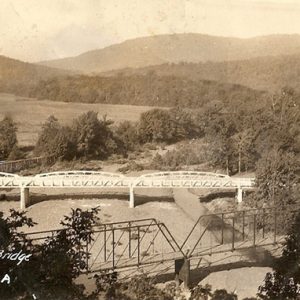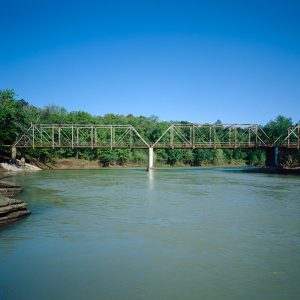calsfoundation@cals.org
Mulberry River
The Mulberry River, a tributary of the Arkansas River, rises from the intersection of several streams in the Ozark Mountains of northern Franklin County and Johnson County. It flows generally southwest from its source and empties into the Arkansas River south of the city of Mulberry (Crawford County), for a total length of approximately seventy miles. Reportedly named for the number of mulberry trees growing in its vicinity, it is today well known among canoeists.
The area around the Mulberry River has been the site of human habitation as far back as approximately 10,000 BC. In historic times, the Osage Indians claimed much of this part of Arkansas, including the area drained by the Mulberry River, as their hunting grounds. The Cherokee settled in the area after leaving northeastern Arkansas and were formally given land in much of northwestern Arkansas in 1817, though they were later pressured to cede these lands in 1828. Permanent white settlement in the Mulberry River valley began soon thereafter, mostly along the lower reaches of the river, near where it empties into the Arkansas River. The largest of these settlements was the community of Mulberry, which got its start after the completion of the Little Rock and Fort Smith Railroad in 1876.
As Margaret and Harold Hedges wrote of the river in 1975 in Arkansas Game and Fish, “It offers an infinite variety of fast water, slow water, roaring rapids, rock gardens, choppy chutes, twisty channels—all sandwiched between pools of deep milky water that is serene and beautiful.” The nature of the river has thus defied use as a transportation corridor for the region, though it has attracted canoeists and kayakers from across the nation, and several businesses along the course of the river offer canoe rentals. On April 22, 1992, 19.4 miles of the river were federally designated as “scenic,” while another 36.6 miles were designated “recreational.” The Nature Conservancy maintains the Mulberry River Preserve in Franklin County
In 2010, a large amount of mud and silt entered the Mulberry River from Mountain Creek, a tributary. This was the result of road work on Arkansas Highway 23, which was damaged during a landslide brought on by heavy rains. Work is ongoing to restore the river to its previous state. The Mulberry River is home to several fish species that are of special conservation concern, including the longnose darter (Percina nastua), fantail darter (Etheostoma flabellare), and stippled darter (Etheostoma punctulatum).
For additional information:
Burgess-Conforti, Jason Richard. “The Potential Acidification of the Mulberry River, Arkansas.” PhD diss., University of Arkansas, 2019. Online at https://scholarworks.uark.edu/etd/3268/ (accessed July 6, 2022).
Griffin, Emily. “Whitewater Adventure.” Arkansas Wild, May/June 2011, pp. 16–18.
Hedges, Margaret, and Harold Hedges. “The Mighty Mulberry.” Arkansas Game and Fish 7 (Spring 1975): 12–16.
Staff of the CALS Encyclopedia of Arkansas
 Highway 23 Bridge
Highway 23 Bridge  Mulberry River Bridge
Mulberry River Bridge  Pig Trail Bridge
Pig Trail Bridge  Turner Bend
Turner Bend  Wire Ford Bridge
Wire Ford Bridge 




Comments
No comments on this entry yet.